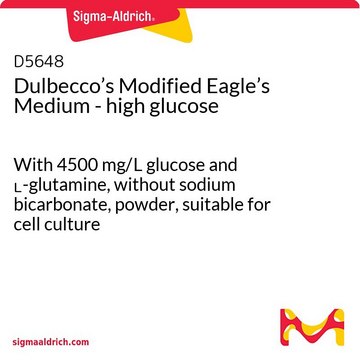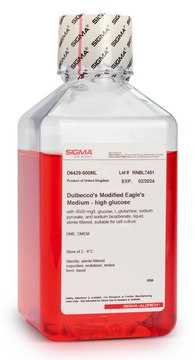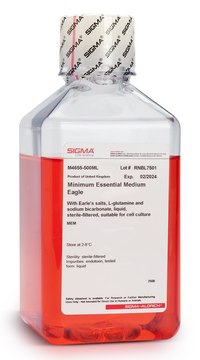Alle Fotos(1)
Wichtige Dokumente
D7777
Dulbecco Modifiziertes Eagle-Medium – hoher Glucosegehalt
With 4500 mg/L glucose, L-glutamine, and sodium pyruvate, without sodium bicarbonate, powder, suitable for cell culture
Synonym(e):
DME, DMEM
Anmeldenzur Ansicht organisationsspezifischer und vertraglich vereinbarter Preise
Alle Fotos(1)
About This Item
UNSPSC-Code:
12352207
NACRES:
NA.75
Empfohlene Produkte
Qualitätsniveau
Form
powder
Methode(n)
cell culture | mammalian: suitable
Komponenten
glucose: high
sodium pyruvate: yes
NaHCO3: no
HEPES: no
phenol red: yes
L-glutamine: yes
Versandbedingung
ambient
Lagertemp.
2-8°C
Suchen Sie nach ähnlichen Produkten? Aufrufen Leitfaden zum Produktvergleich
Anwendung
Dulbecco′s Modified Eagle′s Medium (DMEM) ist eine Modifikation des Basal Medium Eagle (BME) mit vierfacher Konzentration der Aminosäuren und Vitamine. Die ursprüngliche Formulierung enthielt 1000 mg/l Glucose und diente zur Kultivierung von embryonalen Mäusezellen. Seitdem wurde es auf verschiedene Arten modifiziert, um damit Primärkulturen von Mäuse- und Hühnerzellen sowie verschiedene normale und transformierte Zellen kultivieren zu können. Jedes dieser Medien enthält eine andere Kombination von L-Glutamin und Natriumpyruvat. Außerdem wurde die Glucosekonzentration auf 4500 mg/l erhöht, dieses Medium wird als „DMEM/High“ bezeichnet.
Menge
Formulierung enthält 13,5 Gramm Pulver pro Liter Nährmedium.
Rekonstituierung
Ergänzungsmittel mit 3,7 g/l Natriumbicarbonat
Ergänzung
Produkt-Nr.
Beschreibung
Preisangaben
auch häufig zusammen mit diesem Produkt gekauft
Produkt-Nr.
Beschreibung
Preisangaben
Ähnliches Produkt
Produkt-Nr.
Beschreibung
Preisangaben
Lagerklassenschlüssel
13 - Non Combustible Solids
WGK
WGK 1
Hier finden Sie alle aktuellen Versionen:
Besitzen Sie dieses Produkt bereits?
In der Dokumentenbibliothek finden Sie die Dokumentation zu den Produkten, die Sie kürzlich erworben haben.
Kunden haben sich ebenfalls angesehen
Assaf Almog et al.
PLoS computational biology, 15(5), e1006934-e1006934 (2019-05-03)
Neural systems are organized in a modular way, serving multiple functionalities. This multiplicity requires that both positive (e.g. excitatory, phase-coherent) and negative (e.g. inhibitory, phase-opposing) interactions take place across brain modules. Unfortunately, most methods to detect modules from time series
Emilia Galli et al.
Cell transplantation, 28(4), 413-424 (2019-03-08)
Cerebral dopamine neurotrophic factor (CDNF) shows beneficial effects in rodent models of Parkinson's and Alzheimer's disease. The brain is a challenging target for protein therapy due to its exclusive blood-brain barrier. Hence, the therapeutic protein should be delivered directly to
Otávio Valério de Carvalho et al.
Virology journal, 14(1), 124-124 (2017-06-28)
Canine distemper (CD) is a widespread infectious disease that can severely impact a variety of species in the order Carnivora, as well as non-carnivore species such as non-human primates. Despite large-scale vaccination campaigns, several fatal outbreaks have been reported in
Jie Wang et al.
Molecular medicine reports, 22(2), 1111-1118 (2020-07-07)
Neuromyelitis optica (NMO) is a severe neurological demyelinating autoimmune disease that affects the optic nerves and spinal cord. There is currently no effective cure or therapy. Aquaporin‑4 (AQP4) is a known target of the autoimmune antibody NMO‑IgG. Therefore, binding of
Agnieszka Cześcik et al.
Polish journal of microbiology, 63(2), 203-209 (2014-08-15)
With the implementation of the WHO strategic plan for the elimination of measles, the number of measles cases in European Region has decreased. However, outbreaks are still observed. Although most measles cases affect unvaccinated individuals, cases with vaccinated persons are
Unser Team von Wissenschaftlern verfügt über Erfahrung in allen Forschungsbereichen einschließlich Life Science, Materialwissenschaften, chemischer Synthese, Chromatographie, Analytik und vielen mehr..
Setzen Sie sich mit dem technischen Dienst in Verbindung.




